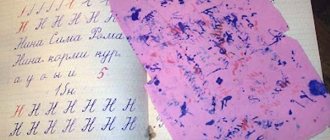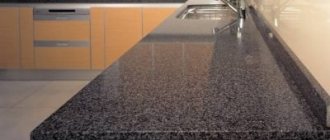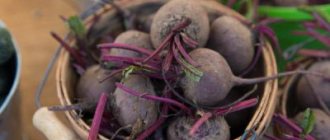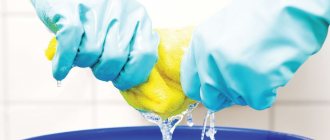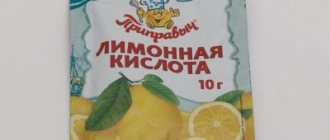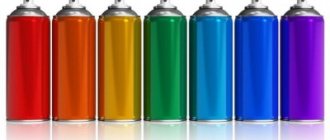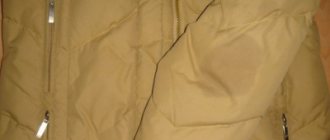What could be more annoying than your own carelessness or someone else's carelessness? Have you ever watched in confusion as a stain from spilled coffee or tea slowly spreads across an important document? Or be angry with yourself for putting paper on the grease-stained table? Happened to everyone!
Unnecessary pieces of paper can be thrown into the trash, but to restore an important document, you will need some knowledge and advice from those who have already found themselves in similar situations.
Methods for removing grease from various types of paper
With the help of available products, you can completely remove the stain, without the need to use chemicals. There are two main principles: destruction of pollution or its absorption.
Notebook
To remove stains from a notebook, you need to prepare a paste of water and chalk. The mixture is applied to a notebook sheet, a piece of paper is placed on it, then the area is ironed. It should be noted that this method cannot be used for important documents, as the structure may be damaged.
Passport
Identification documents must be in good condition: without blots, torn sheets and unnecessary inscriptions.
There is a fairly simple way to get rid of grease stains on paper using simple chalk. First, the stain is sprinkled with chalk, crushed in a mortar. After this, you need to iron the page with a warm iron, not forgetting to place a napkin between the hot iron and the document.
Important! A fresh stain is easier to remove than a dried one. For this reason, you can’t wait until the blot is absorbed - you need to start cleaning it off immediately.
Wallpaper
Paper wallpaper requires a special approach, since its structure is easily damaged even by simple cleaning.
There are 3 simple ways:
- White bread. You can apply a piece of bread pulp and let the dirt soak in if the stain is fresh.
- Iron and paper towel. Place a napkin over the stain and run a hot iron over it. The intermediate sheet changes as it gets dirty.
- Eraser. The stain can be rubbed with a regular pencil eraser. However, you shouldn't put in a lot of effort to avoid making a hole.
Important! Vinyl or non-woven wallpaper can be cleaned with household chemicals, but they cannot be used for paper coverings.
How to remove a stain and save text
A mixture of gasoline and crushed chalk is prepared. The product is applied to the greasy stain and dried, and when finished, just remove the crust and wipe the sheet with a paper towel. This is an effective method, since all records are saved and images are not erased, which is critical for documents.
Gasoline without impurities is used. Another important condition is the addition of chalk, since the product itself spoils the paper.
Helpful information
Tips that will come in handy when removing stains from paper:
You need to start removing the stain immediately, the longer it stays on the surface of the paper, the deeper it is absorbed into the structure; dealing with an old stain is much more difficult than dealing with a fresh one;- you need to remove the stain from the edge to the center so as not to smear it over clean areas;
- if the stain was not removed the first time, the procedure can be repeated, but only after the paper has dried;
- To remove small stains, use a cotton swab; if the contamination is extensive, use a cotton pad;
- in order not to go beyond the boundaries of contaminants, they are outlined with a wax candle;
- Before you begin to remove stains from an important document, the selected product should be tested on a sheet of paper similar in structure to the original.
Other folk remedies
Experienced housewives know how to remove oil from paper without chemicals. You can get rid of stains at home using available products, causing less damage to your documents.
Iron
As a rule, a heated iron is used in combination with other methods. If the stain is fresh, you can place a napkin on the sheet and run a warm iron over the stain - this will absorb the grease.
Oat flour
Oatmeal is an excellent absorbent that often helps housewives in removing fresh dirt. Before the procedure, the cereal is finely ground and then poured onto the problem area. When the fat is absorbed, the flour can be carefully wiped off with a napkin. As a rule, you have to wait about 5 minutes.
Starch and flannel
Starch is poured onto the stain and rubbed with a pre-moistened flannel cloth. The procedure lasts until the dirt is completely absorbed.
The method cannot be applied to thin paper, as it is easy to tear the sheet when rubbing.
Petrol
For the procedure you will need:
- clay;
- petrol;
- simple tooth powder without impurities.
The ingredients are mixed, then applied to the stain and gently scrubbed off with a sponge.
Chalk
The powder is poured onto the greasy mark and covered with a piece of paper. Next, the problem area is ironed and the chalk is removed.
White clay
The procedure requires powdered clay. It is mixed with water to form a paste, after which it is distributed on the dirt and dries. The crust is cleaned off with a sponge, and the document is wrapped in napkins.
We recommend:
Hiddo - review of Japanese washing gel
Bread
The first step is to grind the chalk and apply it to the stains. So the document should lie for 2-3 days, after which the resulting crust is scraped off with a crumb of bread.
Black bread is used a little differently: you can immediately rub the crumb into the stain until it disappears. It is important that the bread is fresh.
Salt
Table salt helps with many stains, be it clothes or paper:
- Fine salt is suitable for this procedure. If the grains are large, you can grind it in a mortar.
- Salt is poured onto the stain.
- The blot is covered with a napkin and heated with an iron.
- If the salt is contaminated, a new portion is poured.
You need to monitor the temperature and not heat the iron too much, as the text may be imprinted on the salt. The mode is suitable for ironing synthetic fibers.
Eliminate odor
There is a simple but effective method to eliminate the smell of damp book pages:
- Take regular baking soda.
- Turn over the pages of the book.
- Cover and leave for several days.
- Shake out the baking soda with your hands/hairdryer/vacuum cleaner.
Soda is known for its ability to absorb unpleasant odors; it is often used to freshen rooms, for washing and cleaning various items, including books.
How to get rid of grease stains on paper using solvents and other chemicals
Getting rid of stains is also possible with the help of aggressive means, but you need to ensure that the paper does not deform or tear.
Alcohol
For cleaning, use alcohol that does not have color or impurities - vodka or alcohol.
First, paper is placed over the stain to allow the greasy marks to absorb. After this, the area is wiped with a soft cloth. Next, you need to take a clean sponge soaked in alcohol and briefly apply it to the problem area. The soiled sheet is laid with napkins and ironed with a warm iron.
Turpentine
The pure product is heated, but not brought to a boil. Using a brush, apply a little turpentine to the blot and place a few clean paper towels on top. The greasy mark is treated with a hot iron for 3–5 minutes.
Fat Solvents
Using such products, removing grease stains without harming documents is quick and easy, and most importantly, effective. Consultants can explain how to properly remove fat from paper without damaging its structure. Solvents do not require any serious effort, but you must read the instructions before use. It is recommended to test the product to ensure its safety. A good solvent should include purified gasoline or alcohol. At the same time, you cannot use detergents with soap, since the components in the composition spoil the paper and smear the text.
The book is damp: what to do
It will not be easy to return the pages to their original appearance in this situation. Place sheets of filter paper between the pages, or sprinkle with talcum powder. Close the book and build a press. Cornmeal will also help prevent mold. You can use a weak jet from a hair dryer or a vacuum cleaner with a narrow nozzle.
Important What you should not do is dry books on radiators, in direct sunlight, or with a hot iron.
Storage recommendations
The way books are kept largely determines their condition. The storage location should not be damp. Recommended temperature and air humidity parameters: 18-22° C and 50-60%.
Books should not be exposed to direct sunlight. Store them on closed shelves in an upright position. Do not place them too tightly and on top of each other - the pages should “breathe”.
Don't forget to wash the shelves where books are stored. Return everything to its place only after the cabinets have completely dried.
Cleaning is important not only for the safety of books. Some people are allergic to paper dust. Having picked up a copy, instead of the pleasure of reading, they get streams from their eyes and nose. Take care of the proper storage of books and the good health of the people in the house, and then the library will become your pride.
We recommend: How to clean carpet at home: a review of quick and effective methods
Little tricks
There are features of removing coffee traces from paper media, among which I would especially like to highlight the following:
- vinegar and chloride solutions are ONLY suitable for processing printed text. If the text is handwritten on a sheet of paper with paste or ink, this method is absolutely not suitable, since the chemical components will simply destroy both the ink and the document;
- dry clay in powder form must be clean, that is, without flavors, dyes and other impurities. The optimal clay can be purchased at a pharmacy.
It is possible to save a business plan or contract from coffee stains, but it is better to either refrain from reviewing important papers while enjoying coffee, or “keep” them in transparent files.
Coffee spilled on equipment is the worst thing that can happen in the office - the keyboard will have to be disassembled and washed, but the laptop may not be saved at all. It is not for nothing that in most offices of Western companies, drinking coffee at the desk, as well as tea, is prohibited. Return to content
Method number 3: Bread crumb
You can get rid of fresh grease stains on a piece of paper if you use this method. To do this, you only need to prepare the bread crumb and that’s it. However, it is worth considering that the bread needs to be fresh.
You will need to use gentle circular movements with light pressure to treat the dirt with the bread crumb. In this case, crumbs that have absorbed fat should be systematically removed.
Coffee and carpet
If liquid has spilled on a luxurious carpet, there is no need to panic. There are many recipes that allow you to tidy up expensive flooring and remove drips and stains from it:
Coffee surprises in the form of drips and stains from any fabric can also be removed with hydrogen peroxide and a light ammonia solution.
Return to content
Special cases
There are several recommendations that will help get rid of dirt on documents and wallpaper.
How to clean paper wallpaper from grease
Some people think that it is difficult to clean wallpaper from traces of grease, but this is not so. When cleaning, you can use damp cloths soaked in a detergent mixture of soap and water.
Important documents
There are three products that will help you clean thin sheets of documents.
Chalk
A piece of chalk must be crushed, and then the stain should be covered with powder. After three days, it is rubbed over the surface with bread crumb.
Napkins and heavy books
To remove fat you will need two napkins. One of them is placed under the spot, and the second is placed on it. A thick book or any other massive object weighing 400-500 grams is placed on top. The napkins are removed after 3-5 days.
Soda
The grease mark is covered with a thin layer of soda, which is left on the paper for 10-12 hours. If a stain remains after baking soda, the procedure is repeated.
How not to spoil an important document
Even the most gentle methods can ruin the text, so decide right away whether it is necessary to remove the grease stain. If the speck is small and does not damage what is written or drawn, then it is better not to touch it. But if cleansing is necessary, then you should follow simple rules:
- Consider the importance. The more important the documentation, the more careful you should be with the papers.
- From simple to complex. Fresh grease contamination should be sprinkled with flour or soda. When this doesn't help, try other techniques.
- Be careful with liquids. Before working with liquid compounds, you should make sure that they will not smear the dye. It is better to test the solution on a sheet of paper with a similar texture and typographic design. If this is not possible, then before working on a greasy, especially old, stain, you should lightly rub a corner of the design or part of the letter with a cotton swab dipped in the solution. When smearing printing ink, you will have to stop using liquids.
- Do not moisturize excessively. Excess liquid will warp the paper sheet.
- Don't rub. Friction causes pellets to form, and what is drawn or written becomes unclear.
- Be careful with the iron. Before ironing, set the device to minimum power. Excessive heating will cause the greasy stain to “bake”, and the stain will be impossible to remove. In addition, there is a risk that with strong heat the text will be damaged by being imprinted on a blotter or napkin.
The basic rule: the thinner the paper, the more careful you work with it. It is better not to completely clean off the grease stain than to damage the document.
There are many ways to clean grease stains from a sheet of paper, and it is not always possible to immediately find one that will effectively deal with the problem. You need to start by using dry bulk materials that absorb oil well, and if this does not help, then move on to ironing or try to “wash away” the greasy blot with liquids. Any of the proposed techniques can damage the printing ink, so you need to proceed with caution when testing the chosen technique on a sheet of similar printing or on a small area of the document.
